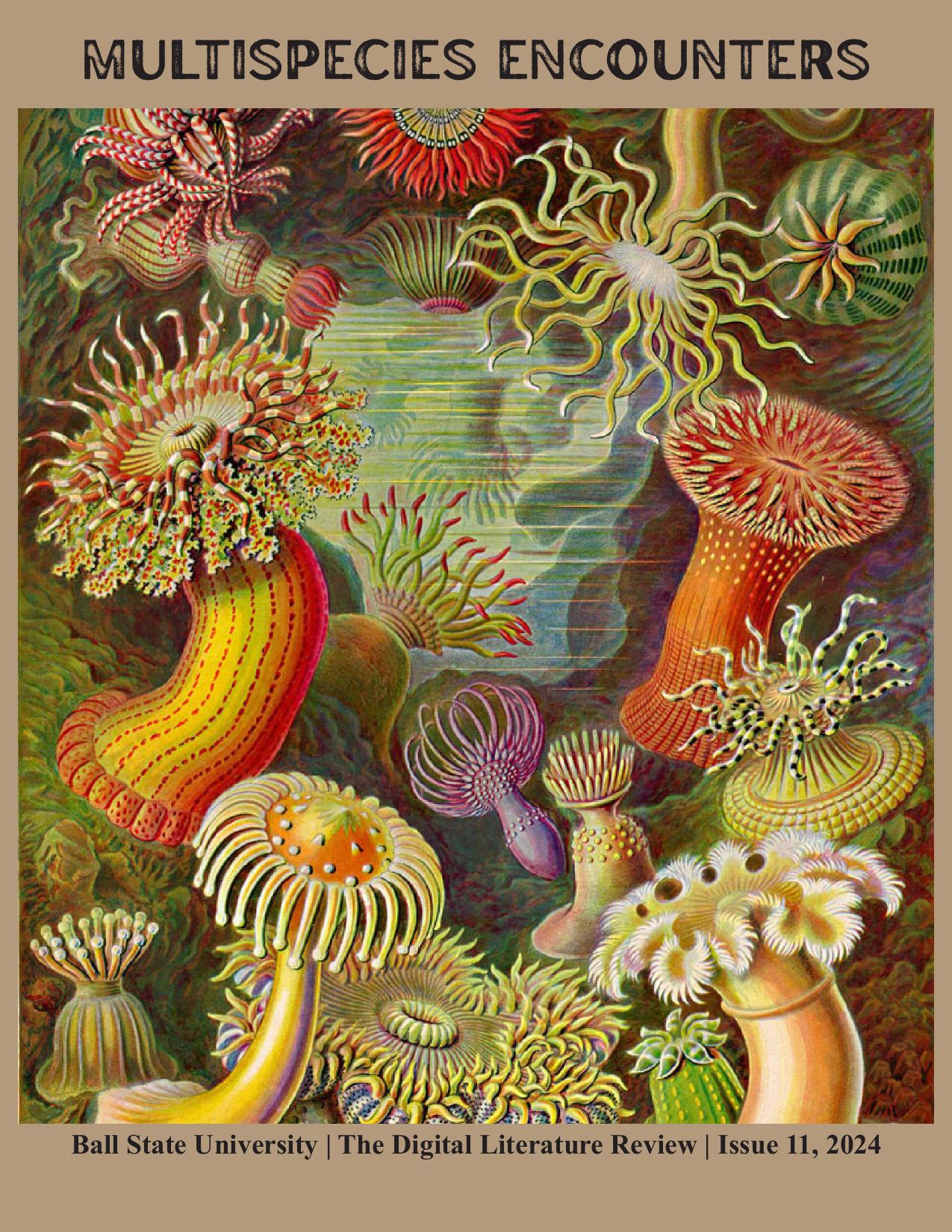The Trees Speak for Themselves
How Non-Human Narrators in Fiction Influence Multispecies Encounters
DOI:
https://doi.org/10.33043/72qzyray5Keywords:
multispecies theory, prosocial behavior, narrative fiction, non-human narrators, non-living narratorsAbstract
Elif Shafak's 2021 novel The Island of Missing Trees describes fictional events that occur on the real island of Cyprus during the war between the Greek and the Turkish inhabitants of the island. This story is told from multiple points of view at various points in time in both Cyprus and London, where the characters move to and live following the events of the war and their families’ disagreements with their relationship. What is unique about Shafak's storytelling is her use of a fig tree as a primary narrator of events. While the use of non-human narrators is not a new strategy, most of these occurrences involve animal speakers rather than plants or objects. In delivering a fiction narrative from the point of view of a fig tree, Elif Shafak's The Island of Missing Trees introduces readers to multispecies encounters by providing an example of how arboreal figures communicate and experience history alongside humans in an anthropocentric world, and further encourages prosocial behavior between human and non-human species. Based on Shafak's novel, theories of attentiveness and slow-violence, and studies on the effect of non-human narrators on readers, including these "non-living" narrators in widely accessible pieces of fiction not only informs audiences of the multispecies encounters that occur in everyday life, but also opens more avenues of multispecies conservation.
Downloads
References
Atayurt-Fenge, Zeynep Z. “The Island of Missing Trees.” World Literature Today, vol. 97, no. 1, 2023, pp. 76–77. EBSCOhost, https://doi.org/10.1353/wlt.2023.0039. Accessed 24 Oct. 2023.
Bernaerts, Lars, et al. "The storied lives of non-human narrators." Narrative, vol. 22, no. 1, 2014, pp. 68-93, https://muse.jhu.edu/article/536491. Accessed 24 Oct. 2023.
Ceballos, Gerardo, et al. "Accelerated modern human–induced species losses: Entering the sixth mass extinction." Science Advances, vol. 1, no. 5, e1400253, 2015, https://www.science.org/doi/pdf/10.1126/sciadv.1400253. Accessed 27 Feb. 2024.
Johnson, Dan R., et al. "Potentiating empathic growth: Generating imagery while reading fiction increases empathy and prosocial behavior." Psychology of Aesthetics, Creativity, and the Arts, vol. 7, no. 3, 2013, pp. 306-312, http://dx.doi.org/10.1037/a0033261. Accessed 24 Oct. 2023.
Lewis, Simon L., and Mark A. Maslin. "Defining the anthropocene." Nature, vol. 519, no. 7542, 2015, pp. 171-180, https://www.nature.com/articles/nature14258. Accessed 24 Oct. 2023.
Małecki, Wojciech, et al. "Can fiction make us kinder to other species? The impact of fiction on pro-animal attitudes and behavior." Poetics, vol. 66, 2018, pp. 54-63, https://doi.org/10.1016/j.poetic.2018.02.004. Accessed 24 Oct. 2023.
Middelhoff, Frederike, and Arnika Peselmann. "The Stories Plants Tell: An Introduction to Vegetal Narrative Cultures." Narrative Culture, vol. 10, no. 2, 2023, pp. 175-188, https://doi.org/10.1353/ncu.2023.a903843. Accessed 24 Oct. 2023.
Negishi, Takayo, and Hirotsugu Kanno. "Earthquake and War-Damaged Trees in Urban History: Non-Destructive Tree Diagnosis Using Sonic Tomography." Land, vol. 12, no. 10, 2023, pp. 1931, https://doi.org/10.3390/land12101931. Accessed 24 Oct. 2023.
Nixon, Rob. Slow Violence and the Environmentalism of the Poor. Harvard University Press, 2011. JSTOR, https://doi.org/10.2307/j.ctt2jbsgw. Accessed 28 Feb. 2024.
O'Neill, Stephen. "Arborealities, or Making Trees Matter in Elif Shafak’s The Island of Missing Trees." Interdisciplinary Studies in Literature and Environment (ISLE), 2023, pp. 1-21, https://doi.org/10.1093/isle/isad040. Accessed 24 Oct. 2023.
Penguin Books Limited Editor. "Elif Shafak on the book she's waited years to write." Penguin Random House, 19 Aug. 2021, https://www.penguin.co.uk/articles/2021/08/elif-shafak-interview-island-missing-trees. Accessed 29 Feb. 2024.
“sentience, n.” OED Online, Oxford University Press, January 2024, https://www.oed.com/dictionary/sentience_n?tab=meaning_and_use#23614708. Accessed 31 Jan. 2024.
Shang, Biwu. "Towards a theory of nonhuman narrative." Neohelicon, vol. 49, no. 1, 2022, pp. 59-73, https://link.springer.com/article/10.1007/s11059-022-00628-y. Accessed 24 Oct. 2023.
Simard, Suzanne W. "Mycorrhizal networks facilitate tree communication, learning, and memory." Memory and learning in plants, 2018, pp. 191-213, https://doi.org/10.1007/978-3-319-75596-0_10. Accessed 24 Oct. 2023.
United Nations. “Causes and Effects of Climate Change.” United Nations | Climate Action, https://www.un.org/en/climatechange/science/causes-effects-climate-change. Accessed 27 Feb. 2024.
Van Dooren, Thom, Eben Kirksey, and Ursula Münster. "Multispecies Studies: Cultivating Arts of Attentiveness." Environmental Humanities, vol. 8, no. 1, 2016, pp. 1-23. Accessed 24 Oct. 2023.
“What beings are not conscious.” Animal Ethics, https://www.animal-ethics.org/what-beings-are-not-conscious/#:~:text=Beings%20that%20have%20no%20centralized,fungi%2C%20plants%20and%20certain%20animals. Accessed 31 Jan. 2024.
Wohlleben, Peter. The hidden life of trees: What they feel, how they communicate—Discoveries from a secret world. Vol. 1. Greystone Books, 2016.
Downloads
Published
How to Cite
Issue
Section
License
Copyright (c) 2024 Digital Literature Review

This work is licensed under a Creative Commons Attribution-NonCommercial-NoDerivatives 4.0 International License.



